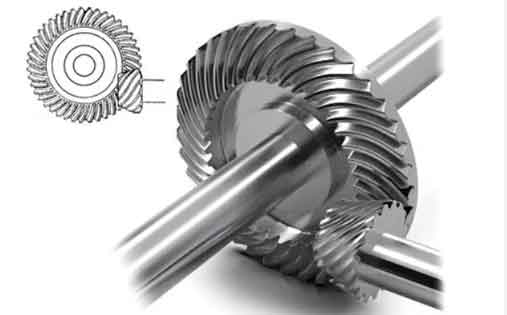Modal analysis is essential for understanding the dynamic characteristics of spiral bevel gears, which are critical components in aerospace and heavy-duty transmission systems. This study focuses on constructing an accurate digital twin model of a spiral bevel gear through experimental and simulation methods to address measurement limitations in traditional modal testing.

1. Methodology
1.1 Modal Testing of Spiral Bevel Gear
The free modal parameters of a spiral bevel gear (Table 1) were obtained using impact hammer testing with 132 measurement points. The modal assurance criterion (MAC) evaluates the orthogonality between mode shapes:
$$MAC(r,s) = \frac{|\{\phi_r\}^T\{\phi_s\}|^2}{(\{\phi_r\}^T\{\phi_r\})(\{\phi_s\}^T\{\phi_s\})}$$
where $\{\phi_r\}$ and $\{\phi_s\}$ represent different mode shape vectors.
| Parameter | Value |
|---|---|
| Number of teeth | 33 |
| Module (mm) | 8.4848 |
| Pressure angle (°) | 20 |
| Spiral angle (°) | 35 |
| Face width (mm) | 46 |
1.2 Digital Twin Construction
The digital twin model was refined using response surface methodology to minimize frequency errors:
$$\min f(E,\rho,\mu) = \sum_{i=1}^{13}|Y_i^{exp} – Y_i^{sim}(E,\rho,\mu)|$$
where $E$, $\rho$, and $\mu$ represent Young’s modulus, density, and Poisson’s ratio respectively.
2. Results and Discussion
2.1 Modal Frequency Comparison
| Mode | Exp. (Hz) | Sim. (Hz) | Error (%) |
|---|---|---|---|
| 1 | 1,436.3 | 1,441.8 | 0.38 |
| 5 | 3,400.5 | 3,400.7 | 0.01 |
| 15 | 8,653.1 | 8,760.0 | 1.24 |
2.2 Mode Shape Correlation
The cross-MAC matrix between experimental and simulated modes demonstrates strong consistency:
$$CrossMAC(r,s) = \frac{|\{\phi_r^{exp}\}^T\{\phi_s^{sim}\}|^2}{(\{\phi_r^{exp}\}^T\{\phi_r^{exp}\})(\{\phi_s^{sim}\}^T\{\phi_s^{sim}\})}$$
Diagonal values exceeding 0.95 confirm spatial correlation of corresponding modes.
2.3 Frequency Response Validation
The simulated frequency response function (FRF) matches experimental measurements:
$$H_1(\omega) = \frac{G_{yx}(\omega)}{G_{xx}(\omega)}$$
where $G_{xx}$ and $G_{yx}$ represent auto-power and cross-power spectra respectively.
3. Key Findings
The digital twin approach enables:
- Identification of undetected modes (2,559 Hz and 6,347 Hz) due to sensor limitations
- Correction of experimental errors in closely spaced modes (8,653-8,760 Hz)
- Comprehensive modal parameter extraction with maximum frequency error <1.24%
This methodology effectively solves the measurement incompleteness and inaccuracy problems in spiral bevel gear dynamics analysis, providing a reliable foundation for vibration prediction and structural optimization.
